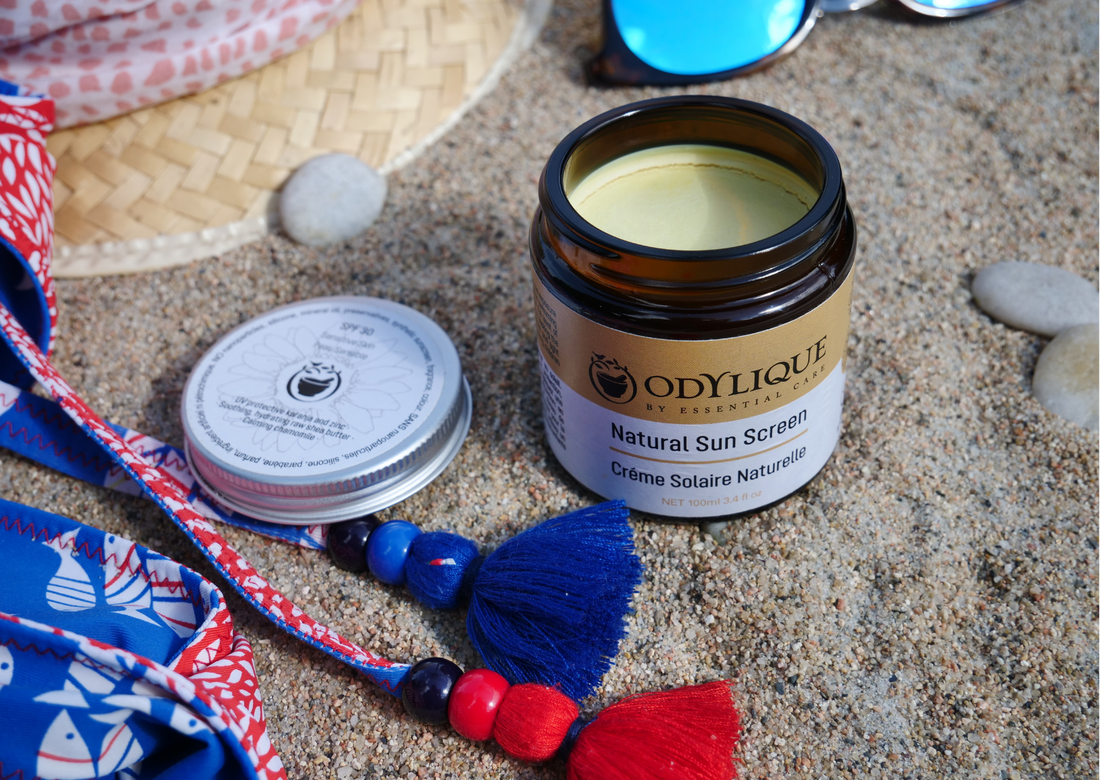And why we prefer mineral suncreams!
At our natural skincare store, we advise that sun protection is one of the best ways to prevent your skin from premature ageing and should be your first line of defence before we reach for the more hard core skincare products. But we often hear our customers say that they don't wear sunscreen because they have safety concerns around the ingredients within sun protection products.
If you're unsure, read on for the difference between chemical and physical (mineral) suncream and why we think mineral suncream is the best to use on your skin.
But first, it's important to clarify the word chemical as sometimes there can be a misconception that all chemicals are harmful. However, we, and everything around us are made up of chemicals, even water is a chemical for example, and so nothing can truly be classed as chemical free. Where fears exist around skincare ingredients, this generally relates to something being made with harmful chemicals. In this case, we would use the terminology, 'non toxic' when highlighting products that are generally accepted to be safe to use.

What is chemical sunscreen?
Chemical sunscreens work by absorbing into the skin and when UV rays come into contact with the suncream a reaction occurs that dissipates the UV rays before damage is caused to your skin. They are called chemical, because a chemical reaction is taking place to provide that sun protection.
The most commonly used ingredients are oxybenzone, avobenzone, and octinoxate and while their names are tricky to pronounce, these ingredients work like a sponge to soak up the harmful ultraviolet rays.
What is mineral sunscreen?
Mineral and physical sunscreens are one and the same and they sit on top of the skin and act as a physical block against the sun's rays. Physical sunscreens use two main active natural ingredients – zinc oxide and titanium dioxide - and generally have fewer ingredients in them than chemical sun lotions.

How to tell if a sunscreen is mineral or chemical
You can tell what type of sunscreen you have by turning the bottle or jar over and checking the INCI (ingredient) list on the back of the packaging to check for the active ingredients. Some typical active ingredients are highlighted below:
| Chemical Sunscreens | Mineral Sunscreens |
| Oxybenzone |
Zinc Oxide |
| Avobenzone |
Titanium Dioxide |
| Octinoxate |
|
The texture of your sun lotion may also give you a clue as to whether it's chemical or physical. Chemical sunscreens tend to be lighter lotions and mineral sunscreens are typically thicker and require some more rubbing in. Some mineral sunscreens may leave a white cast on your skin depending on skin tone so it also requires a bit of trial and error to get the right one for you.
A note on nanoparticles in sun creams
Nanoparticles are particles that are less than 100 nanometers in size (1 nanometer is 1/100,000 the width of a human hair!) and are concerning because there is some debate about whether they can change the make up of our skin cells. Here's where mineral sun screen can get a little murky, because sometimes zinc oxide and titanium dioxide use nano-sized particles to minimise the whitening effect that mineral suncreams can sometimes have on the skin.
If you'd prefer to steer clear of nanoparticles, then make sure you check that your sun cream states on it that the active ingredients are non-nano. You can also be sure that any Soil Association approved products are non-nano because any ingredients with particles under 200nm are prohibited by them so look out for the Soil Association logo.

Why choose a mineral sunscreen?
As we mentioned above, some people have safety concerns over toxic ingredients in chemical suncreams and so prefer to use mineral SPFs because they sit on top of the skin rather than being absorbed into it. Ingredient concerns aside, sensitive skin types, or those who are allergic to some sun lotions or acne sufferers may also prefer the gentler ingredients in mineral sun creams and a shorter ingredient list.
Then there's usability. If you're itching to get out and about in all weathers, you may prefer the convenience of mineral suncreams because, unlike chemical sun creams, which must be fully absorbed into the skin before they become effective (taking upwards of 15 minutes), mineral sunscreens are effective as soon as they are applied.
Benefits of mineral sun creams
- Water resistant once applied to the skin - with either chemical or mineral suncreams you should always reapply when getting out of the pool or sea
- UVA and UVB protection - zinc oxide, the active ingredient in mineral suncream, is highly photostable so it offers excellent UVA and UVB protection as it won't lose its protective power under exposure to UV light. This is essential for preventing premature ageing and skin health issues. Titanium dioxide offers slightly less UVA protection so you'll see zinc oxide most often on ingredient lists for mineral suncreams.
- Reef safe and eco friendly - the key ingredients in most chemical suncreams can be harmful to marine life and coral reefs whereas mineral suncream's key ingredients are generally thought to be more environmentally friendly and not likely to cause coral bleaching or impact marine life
- Zinc oxide is associated with a number of health benefits - It can soothe irritation (ideal if you've had a little sunburn), won't blog pores as it's non comedogenic and its antibacterial, anti-inflammatory properties may preserve skin elasticity, the appearance of wrinkles and help to combat acne


